
The Atmospheric Chemistry of Combustion Emissions Near the Tropopause (ACCENT) mission is an interagency mission to study the effects of rockets and aircraft in the upper troposphere and lower stratosphere. ACCENT is jointly sponsored by the Atmospheric Effects of Arcraft Program (AEAP) and the Rocket Impacts on Stratospheric Ozone (RISO) program (see some RISO highlights). As part of that mission, the NASA GSFC aircraft field missions group has been providing flight planning tools and meteorological support in real time for the mission project scientists.
Following are a few pictures of the April 1999 ACCENT deployment. We are using the WB-57F aircraft for carrying the ACCENT payload (See the USAF Museum page for WB-57F history). We are based at Ellington Field just outside of Houston, TX. Ellington Field is part of the Johnson Space Center. All of the Johnson aircraft are based here.
The WB-57F is based in Hangar 990 here at Ellington Field. Here we see the
WB-57F being pulled out of 990 prior to the successful ATLAS rocket intercept
of April 12, 1999.

The ACCENT instrument and support people are housed in a small
building just next to hangar 990 in Building 994. Our group is from
the NASA Goddard
Space Flight Center . In particular, we work in the Atmospheric Chemistry and Dynamics
Branch (Code 916). Our office here at Ellington is located in the far
left corner (third window on the left of the picture).
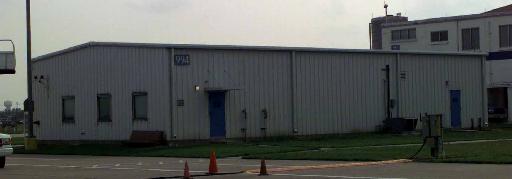
Our workspace is a bit constricted. We have to squeeze 4 people on
to these two small tables. Here we see Tom Kucsera showing a happy face
because the other folks aren't cheek to jowl with him this instant.

Here's our GSFC Code 916 group here in building 994. Left to right are
Leslie Lait, Tom Kucsera, and Paul Newman.
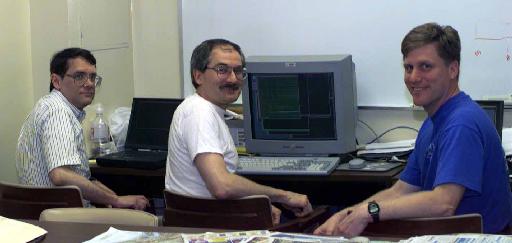
Anne Thompson came down of April 15 for the takeoff of the WB-57F on
the Delta II intercept. In this picture, she's highly amused by our small
work area.
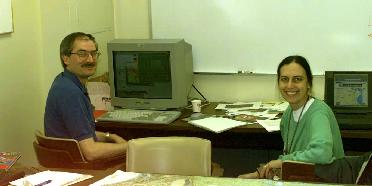
Of course, we're not the only folks providing met support here for ACCENT. Rennie
Selkirk (left, NASA ARC SWISS
group) and Karen Rosenlof (right, NOAA/AL) are also doing met work for ACCENT.
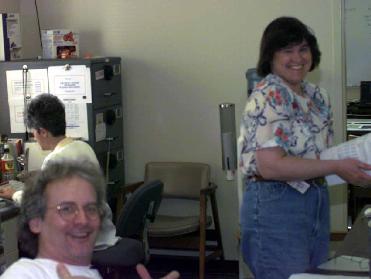
We have a relatively large team here. From left to right are Kathy
Wolfe, Randy Friedl, Marty Ross, and Adrian Tuck with his head turned away
from the camera. Randy and Marty are
the project scientists for ACCENT. Note the typical exhausted look characteristic
of the project scientists.
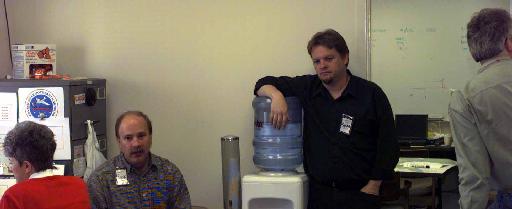
The WB-57F is the workhorse aircraft for ACCENT. The WB-57F is
modified from the Martin B-57 Canberra light bombers. The WB-57F is
capable of carrying a 4000 lb. payload to altitudes over 60,000 ft,
and with a range in excess of 2300 nautical miles. Here we see the
WB-57F on April 12, 1999.
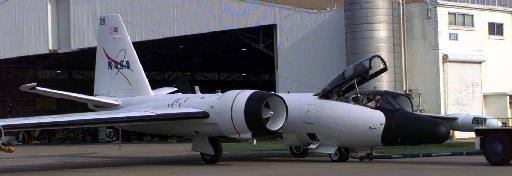
More WB-57F photographs? Yes!
Here we see the payload
(bombbays) for the WB57, where the instruments fit into the aircraft.
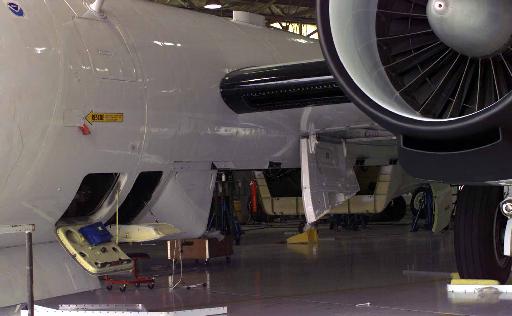
Here we see the pallet with Darin Toohey's CORE (ClO) and CO2 instruments begin
wheeled into Hangar 990 on Monday morning (4/12/1999) by Amelia Gates and Erik
Richard.
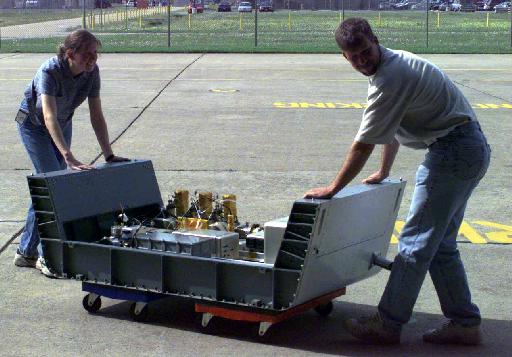
Bernie Lefleur already has the Denver University particle instrument's pallet
rolled into Hangar 990.
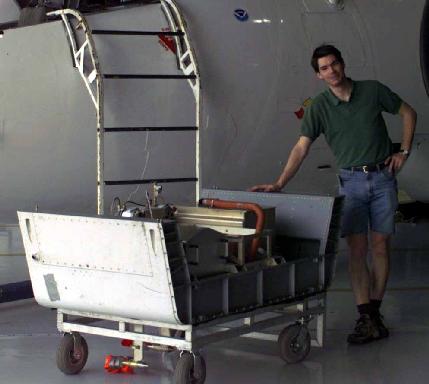
The pallets are now rolled under the plane and attached.
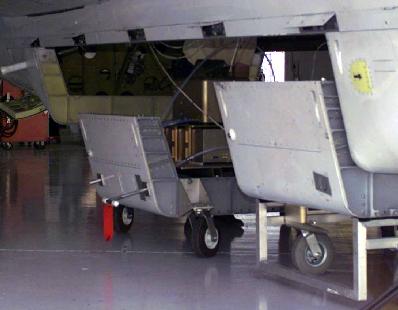
After attachment, we can see the 2 front inlets for the Denver University
particle instruments, the middle inlet is for CCN, and the left side inlet
(with the power cord draped across it) is for ozone. The CORE & CO2
inlets,
as well as the REMS mass spec
inlet are out of view on the other (port) side of the fuselage.

The right hand spear pod (starboard wing) has the JPL MTP instrument
for temperature profiles (the knob at 9 o'clock on the pod, the NOAA/AL
Lyman-alpha water instrument at the front of the pod, and the NCAR MASP
particle instrument (the missile shaped inlet in the shadows at about 5
o'clock on the pod).

The left hand spear pod (port wing) has the University of
Missouri particle instument.
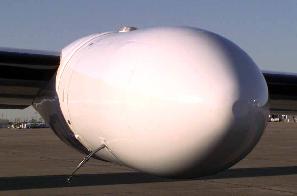
Here we see the WB-57F being prepped for the April 12, 1999 ATLAS rocket
intercept flight. The pilot and backseater are in the cockpit, and Marty Ross (in the
foreground with the blue shirt) is walking over to give the pilot instructions on how to fly.
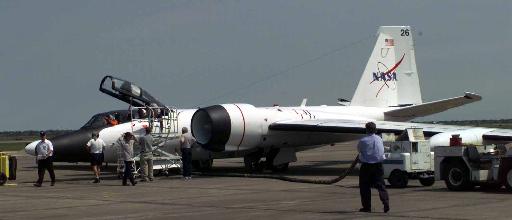
A principal goal of ACCENT is to understand how rockets impact the stratosphere. One of our flights was to intercept the plume from a Lockheed Martin Atlas 2AS rocket. The Lockheed Martin Atlas 2AS rocket took-off on April 12, 1999 (Monday) at 6:50 p.m. EDT, successfully deploying the Eutelsat W3 satellite.
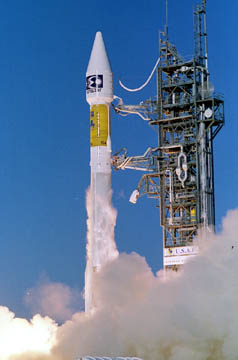 The WB-57F made 11 passes through the plume of this rocket
at altitudes between 58,000 and 62,000 feet beginning 8 minutes after
the launch. Shelley Hilden of NASA/JSC (the WB-57F backseater) snapped
off a number of images of the ATLAS plume following the launch.
The WB-57F made 11 passes through the plume of this rocket
at altitudes between 58,000 and 62,000 feet beginning 8 minutes after
the launch. Shelley Hilden of NASA/JSC (the WB-57F backseater) snapped
off a number of images of the ATLAS plume following the launch. More of those great Shelley Hilden plume photographs?
On April 15, 1999 at 11:32 PDT, a Boeing Delta II rocket was launched carrying the Landsat-7 Earth-imaging spacecraft into orbit.
Delta II plume pictures from the WB-57F
Other pictures of things at and near Ellington
Photos taken by Paul A. Newman of NASA/GSFC.
Go to the available forecast plots? Yes.
Last Updated: 1999-04-11
Author: Dr. Paul A. Newman (NASA/GSFC, Code 916) (newman@notus.gsfc.nasa.gov)
Web Curator: Dr. Leslie R. Lait (Raytheon ITSS) (lrlait@ertel.gsfc.nasa.gov)
Responsible NASA organization/official: Dr. Paul A. Newman, Atmospheric Chemistry and Dynamics Branch